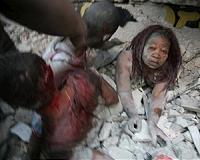| . |  |
. |
Port-Au-Prince (AFP) Feb 13, 2010 Edmond Dimanche sat perched on a pile of rubble in a landfill, recovering metal rods and bricks, anything he can sell for a few pennies to get by. "I have had nothing else to do for some time. I'm surviving by doing this job," said Dimanche, 40, speaking in a mixture of French and Creole. He displayed twisted iron extracted from concrete blocks, sheet metal, and all kinds of plastic, paper and fabric tangled up in the debris. "They sell for very little money," mostly under a dollar, he added. Dimanche's house, like those of so many others here, was leveled by the devastating quake that hit Haiti just over a month ago, killing at least 217,000 people and leaving him and many more to live on the streets. He survives by collecting the most valuable bits he can find from rubble dumped by trucks that bring debris from across the city, and them selling those pieces. "I was passing by here and I stopped to buy something," said one man who had parked his vehicle by the landfill, located not far from the capital's airport. "We can build houses, bridges, anything you want with it," he said, declining to give his name. At "Madame Jimmy's workshop," Beathony Blaise, 26, supervised a group of workers in a courtyard filled with gates, wrought iron furniture and bricks. "The house next door collapsed, and the people who weren't killed have left," Blaise said. Construction and other materials have been in short supply and high demand since Haiti's earthquake, which paralyzed the country's economy. Extracting the materials from the rubble makes them cheaper, but "there is a lot of work to do," Blaise noted, pointing out a long iron rod broken into small dented pieces. But the rod can be transformed into part of a window frame, a balcony, a rocking chair, and that pays, even if only a little. "We've made some 5,000 gourdes (Haitian currency) since the quake," said Blaise, who considers himself lucky to be alive "when people don't even have a tent, don't even have anything to eat." The workshop made about 40,000 gourdes a month before the quake, he said. Behind him, Anous Cadet chipped away at a block of compact concrete -- the material that most homes and buildings in the city were built from, and which proved poorly-equipped to deal with the massive 7.0-magnitude quake. Methodically, he broke down the mortar between the bricks, made of a weak mixture of sand and water, eventually extracting and depositing the unscathed brick on a pile of similarly recovered building blocks. "We'll try to sell these," Blaise said, adding that a nearby brick factory has not resumed operations since the January 12 quake. He would prefer to purchase the base materials himself, which would "be easier than going and looking for something that doesn't belong to us." But the circumstances are far from ideal, and the rubble produces materials that are sorely needed in a city where over one million people were left homeless. Pieces of plastic tubing lay on the ground, further examples of the value that can be extracted from the city's debris. "We'll try to repair them and install them on a ceiling. It's going to rain soon, so we'll clean them and put them end to end to drain the water away," Blase said. "These are for us, we won't be selling these."
Share This Article With Planet Earth
Related Links Bringing Order To A World Of Disasters A world of storm and tempest When the Earth Quakes
 In desolate Haiti, rich few escaped quake unscathed
In desolate Haiti, rich few escaped quake unscathedPort-Au-Prince (AFP) Feb 12, 2010 They drink French water, buy Camembert from Normandy and fine olive oil from Italy, but Haiti's rich are among the lucky few to have escaped unscathed from the killer earthquake a month ago. In upscale Petionville, in the foothills of Port-au-Prince, several markets run by Syrians are stocked with an inventory of products that far surpasses the basic needs that are still largely unmet for ma ... read more |
|
| The content herein, unless otherwise known to be public domain, are Copyright 1995-2010 - SpaceDaily. AFP and UPI Wire Stories are copyright Agence France-Presse and United Press International. ESA Portal Reports are copyright European Space Agency. All NASA sourced material is public domain. Additional copyrights may apply in whole or part to other bona fide parties. Advertising does not imply endorsement,agreement or approval of any opinions, statements or information provided by SpaceDaily on any Web page published or hosted by SpaceDaily. Privacy Statement |